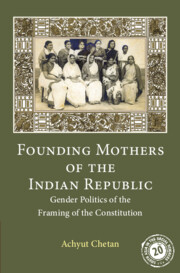Book contents
- Frontmatter
- Dedication
- Contents
- List of Images
- Preface
- Acknowledgements
- List of Abbreviations
- Introduction: Towards a Feminist Reading of the Making of the Constitution
- 1 In the Shadow of the Founding Fathers
- 2 In Search of the Missing Mothers
- 3 Women’s Moral Imaginary and Constitutional Politics: 1927–1946
- 4 Patterns of Participation: Women Members in the Constituent Assembly
- 5 Writing the Rights: Inscribing Constitutional Morality
- 6 Reformulating the ‘Woman Question’: Challenging Customs and Traditions
- 7 After the Framing
- Conclusion: Remembering the Founding Mothers
- Appendix: Texts and Contexts of the Framing – A Timeline
- Bibliography
- Index
2 - In Search of the Missing Mothers
Published online by Cambridge University Press: 27 September 2022
- Frontmatter
- Dedication
- Contents
- List of Images
- Preface
- Acknowledgements
- List of Abbreviations
- Introduction: Towards a Feminist Reading of the Making of the Constitution
- 1 In the Shadow of the Founding Fathers
- 2 In Search of the Missing Mothers
- 3 Women’s Moral Imaginary and Constitutional Politics: 1927–1946
- 4 Patterns of Participation: Women Members in the Constituent Assembly
- 5 Writing the Rights: Inscribing Constitutional Morality
- 6 Reformulating the ‘Woman Question’: Challenging Customs and Traditions
- 7 After the Framing
- Conclusion: Remembering the Founding Mothers
- Appendix: Texts and Contexts of the Framing – A Timeline
- Bibliography
- Index
Summary
The future constitution of the country will affect both men and women equally. Women, therefore, have as much interest in it [Constituent Assembly] as men have, perhaps more, for women would like to see that the new constitution is based on democratic principles and that no disability attaches to any citizen on the grounds of caste, creed or sex and that it provides equal rights and equal opportunities for women in all spheres of human activities.
—Hansa Mehta, 1946The conventional narrative of the formation of the Constituent Assembly praises the Congress for taking a great deal of pain to ensure that the Assembly had representatives of all social and political groups. The party, in the words of the official version, had to be ‘the mirror of the nation’, and ensure that all shades of public opinion were represented in the Constituent Assembly. In Austin's words, ‘The Constituent Assembly was a one-party body in a one-party country. The Assembly was the Congress and the Congress was India.’ For Austin, who also repeats this version, women got some seats in the Assembly through the generosity of the Congress. He bases his claim on the limited archival support of a circular issued by the All India Congress Committee on 4 July 1946, asking that all provincial Congress legislatures elect some ‘specific’ women candidates to the Constituent Assembly. The elections to the Constituent Assembly were to be held between 11 and 22 July 1946. It was ‘certain that the provincial assemblies would elect the individuals recommended by the high command’.
When the Constituent Assembly was finally formed, 15 of its members were women. These were Begum Aizaz Rasul, Begum Jahanara Shahnawaz, Begum Shaista Suhrawardy Ikramullah, Ammu Swaminathan, Dakshayani Velayaudhan, G. Durgabai, Sucheta Kripalani, Vijayalakshmi Pandit, Purnima Banerji, Kamala Chaudhri, Sarojini Naidu, Hansa Mehta, Rajkumari Amrit erased from the memory of the nation in the same way that women have been omitted or erased from history; but these women can be found in the archives. Some of these women are remembered for other reasons, but hardly ever as framers of the Constitution. Two more women were elected to the Constituent Assembly: Renuka Ray from West Bengal when fresh vacancies were created after constituencies from Bengal went to East Pakistan in July 1947, and Annie Mascarene as a representative of Travancore–Cochin in December 1948.
- Type
- Chapter
- Information
- Founding Mothers of the Indian RepublicGender Politics of the Framing of the Constitution, pp. 42 - 76Publisher: Cambridge University PressPrint publication year: 2023

